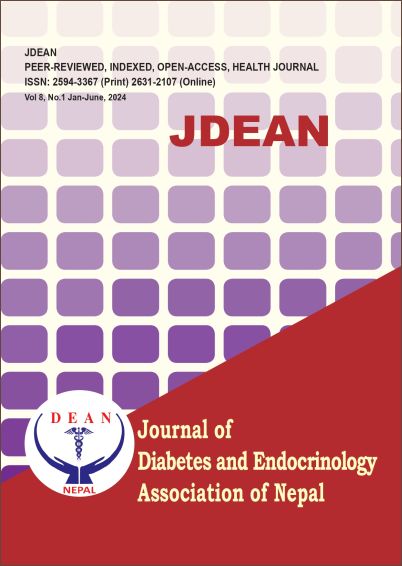Medical Adherence among Type 2 Diabetes Mellitus Patents at Tertiary Care Teaching Hospital of Nepal
DOI:
https://doi.org/10.3126/jdean.v8i1.76642Keywords:
Diabetes mellitus, Medical adherence, Therapeutic benefitAbstract
Background: Diabetes is a chronic, metabolic disease characterized by elevated levels of blood glucose. The most common is type 2 diabetes mellitus which occurs when the body becomes resistant to insulin or doesn't make enough insulin. It is ranked among the 10th leading cause of mortality globally. Proper medication adherence is critical component to control further complications of disease and to obtain higher therapeutic benefit.
Method: It is a hospital based prospective cross sectional study involving 122 patients based on non probability sampling conducted in the tertiary care Teaching hospital. Patients who have been diagnosed with type 2 diabetes mellitus and taking anti-diabetic medicine at least 6 months prior were enrolled. A structured anonymous questionnaire was divided into three parts for data collection. A multivariate binary logistic regression model was applied to identify and compared the variables predictors of medication adherence.
Results: In this study 122 patients diagnosed with type 2 diabetes mellitus taking anti-diabetic medications were enrolled. On the basis of Likert score (29%) had adherence and (71%) had non adherence to medication. (59%) of them had used oral hypoglycemic agent (25.4%) had used insulin only and (17%) had used both. Medication adherence was significantly correlated to the age (r= -0.18, 95% CI= -0.35 to -0.002, p=0.048), sex (r= -0.36, 95% CI= -0.51 to -0.20, p<0.001), education (r= -0.21, 95% CI= 0.04 to 0.38, p=0.018) and occupation (r= 0.24, 95% CI= 0.06 to 0.40, p=0.009) of the participant. Medication adherence was significantly correlated with availability of medicines locally (r= -0.22, 95% CI= -0.38 to -0.45, p=0.014), societal awareness (r= -0.22, 95% CI= -0.38 to -0.04, p=0.016) and confidence with symptoms related to the disease (r= -0.25, 95% CI= -0.41 to -0.07, p=0.006).
Conclusion: Medication adherence was found to be lower among the Nepalese population at the tertiary care hospital. Counseling services and awareness program could be effective for the treatment and prevention of complications of diabetes
Downloads
Downloads
Published
How to Cite
Issue
Section
License

This work is licensed under a Creative Commons Attribution-NonCommercial 4.0 International License.
This license enables reusers to distribute, remix, adapt, and build upon the material in any medium or format for non-commercial purposes only, and only so long as attribution is given to the creator.




